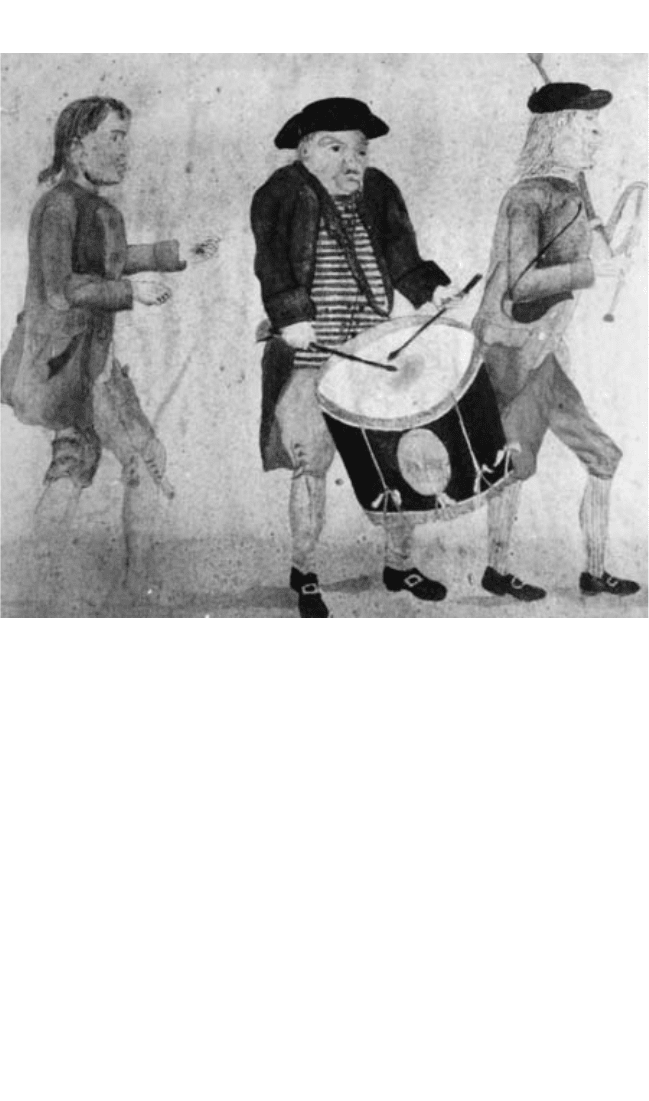Foyster E., Whatley C.A. A History of Everyday Life in Scotland, 1600-1800
Подождите немного. Документ загружается.


282 Christopher A. Whatley
However, as the evidence of county justices of the peace lists of prices
makes clear, there were waged employees in the countryside in the early
1600s – although sometimes fees were prescribed in the form of kindly pay-
ments, most notably in Midlothian where, uniquely, ‘hinds’ and ‘half-hinds’
were paid in the form of a cottage, a kailyard (kitchen garden), a portion of
ground for growing grain and grazing, and some basic foodstuffs. Shoes and
clothing – or an ell of linen from which a shirt or dress could be made – were
sometimes included too, although not only in Midlothian. There and else-
where farm servants hired by the year and half-year at fee-ing fairs, were paid
only in part in money – not necessarily a disadvantage as kindly payments of
items like milk, meal and potatoes sheltered workers from the sharp edge of
rapid price increases, as occurred during the infl ationary 1790s. Many were
expected to bring with them a wife or other female whose labour would be
called upon on a casual, usually seasonal basis to serve the needs of eastern
Lowland Scotland’s mixed agricultural system: sowing; weeding; thinning
and harvesting crops – although if the fi elds were ‘male’ space and females
entering it subordinate (other than at harvest time), within the home it was
the womenfolk who were dominant.
43
Other country dwellers, including
craftsmen such as weavers, wrights, thatchers and shoemakers, and day
labourers, were paid either by the piece or by the day. Their wage could also
include meal, meat and ale and ‘aquavitae’ (whisky), although few made a
living by using their craft skills alone.
44
But virtually everywhere, there was an integral role for the labour of rural
women and children; the quern – for grinding grain by hand – was pretty
well universal in country districts, and food preparation a critical if easily
overlooked element in keeping the labouring household going. But for paid
work, women rarely received more than half the male rate, other than during
the harvest when demand for labour intensifi ed, and there was no improve-
ment in their relative position as the eighteenth century progressed, other
than for those females who were drawn into more or less full-time work as
hand-spinners or as muslin sewers in the countryside.
Towards the end of the seventeenth century, the cash nexus was becom-
ing increasingly prevalent in the Highlands as well as the Lowlands.
45
This
is well-illustrated in north and eastern Perthshire, where fl ax growing and
part-time spinning and linen weaving became widespread. Exports surged
from the 1680s, the greatest part of which was taken south to England
overland by a small and expanding army of what around 1700 comprised
some 1,000 peddlers and hawkers – ‘the great transporters & vendors of
our Linen Manufacture’, according to the magistrates of Glasgow in 1730;
these ‘petty chapmen’ went round the summertime linen fairs and purchased
with ‘ready money’ small quantities of cloth produced for sale by country
weavers, thereby enabling them to ‘pay their rents & provide themselves in
their other necessarys’.
46
Some households turned to brewing, especially in
the vicinity of the buoyant Edinburgh market, and in the remote townships
FOYSTER PAGINATION (M1994).indd 282FOYSTER PAGINATION (M1994).indd 282 29/1/10 11:14:0629/1/10 11:14:06

Work, Time and Pastimes 283
of the Hebrides to whisky distilling as a means of adding value to their grain
crops.
More so than formerly, earnings from manufacturing in the countryside
were the means by which those concerned paid their rents.
47
Indeed, in the
more advanced agricultural regions like Strathmore, cottars and servants
had by the end of the seventeenth century managed to accumulate cash and
other material assets of one sort and other, and some were even in a position
to act as small-scale creditors; formerly such signs of relative affl uence had
been largely confi ned to lairds and bigger tenant-farmers.
48
Yet there were
swathes of the Scottish countryside where the lot of the small sub-tenant and
cottar were desperate; many had diffi culty fi nding the cash portion of their
rent, even in war and famine-free years.
49
During a particularly severe period
of the Little Ice Age – from around 1670 and up to the early 1700s – tenants
on several Highland estates were simply unable to pay their rents, forcing
many to abandon their holdings to become landless seekers of employment
or other means of support.
50
But even a century later, harvest-related distress
in the Lochaber district sent 1,500 females on a desperate search for lint to
spin.
Indeed, until the fi nal third of the eighteenth century, the impression is
of a society where paid employment on a regular basis was not easy to fi nd.
In an economy long dependent upon the export of raw materials and low-
grade semi-manufactures, serious skill bottlenecks emerged, but these were
overcome by enticing workers from England, Ireland and the continent
of Europe, as appropriate; in the eighteenth century glass-making, pottery
manufacture, iron making, bleaching and dyeing all had resort to imported
labour.
51
At particular times and places demand for unskilled workers could
also be acute, above all for the harvest. Even so, visitors frequently com-
mented on the alleged ‘indolence’ of the Scots (although the accusation was
levelled against the labouring poor in England too), which the more percep-
tive recognised not to be a national character failing, but instead a rational
response to the facts of under- and unemployment, and rates of pay which
offered little incentive to work harder; more often the prescription was to
combine low wages with moral reform.
52
By 1800 the vast majority of rural dwellers were either rent-paying farm
tenants, or paid employees, that is, servants of various designations and day
labourers. Indeed, the bulk of the rural labour force now comprised an army
of largely landless labourers – rural proletarians. This was despite the marked
regional variations there were in the ratios of wage-earners to single tenant
farmers, 10:1 at one extreme. This was in the Lothians, where single-tenant
farms had since the fi fteenth century begun to replace most multiple tenan-
cies; a similar situation prevailed in the counties immediately to the south and
across the river Forth to the north. In Ayrshire and the south-west smaller
family-run farms were usual. Despite the predominance of one-plough or
one-pair horse farms in the north-east, even there wage-earners outnumbered
FOYSTER PAGINATION (M1994).indd 283FOYSTER PAGINATION (M1994).indd 283 29/1/10 11:14:0629/1/10 11:14:06

284 Christopher A. Whatley
independent farmers almost three to one. In Ayrshire, however, they were
more likely than elsewhere to be living under the same roof and eating meals
with their employer. But indoor farm servants were to be found outside East
Lothian well into the nineteenth century.
53
Others combined their roles as subsistence farmers and employees, con-
structing a living from multiple by-employments. Estate workers and cottars
might be paid an annual fee from which their employer deducted sums for
the portion of land they held for grazing a cow, housing and any food from
his table. Often crucial was the matter of whether the contract would include
an allowance for clothing and shoes.
54
But the pace of the process of Lowland
clearance just described was far from uniform, and on some estates substan-
tial numbers of cottars remained. Indeed, in low-lying Shetland in the far
north, through the eighteenth century, ‘scattald’ or common land continued
to be held by a rapidly growing population of tenants who, in return for their
landholdings, paid their rents in the form of the (entire) proceeds of their
summer fi shing, along with some butter, oil or animals.
55
In the second half of the eighteenth century, however, there was a more
marked presence of artisans, increasingly working full-time at their trades
(other than in winter, when outside working could be curtailed), who were
now housed in newly-constructed villages: tradesmen like masons, slaters
and carpenters who were employed in building projects; dykers, hedgers and
drainers who helped shape the improved landscape; and smiths and wrights
who made and repaired farm implements. Few places were without a sizeable
cluster of hand-loom weavers, and others with smallholdings who worked
mainly for the aforementioned town- and village-based merchant-organisers
of domestic production.
The difference now was that they were more or less full-time and
employed at a single occupation rather than taking on a range of tasks which
meant that none was performed particularly well.
56
A few butchers and
bakers even found employment, their services in demand as rural incomes
rose.
57
Similar tendencies were visible in the north-east by the end of the
eighteenth century, as fi shing there became increasingly commercialised.
A gendered division of roles was clear too: only men and boys went to sea;
women – and children – baited lines and dealt with the catch, although the
sight of Newhaven fi shwives selling their wares in Edinburgh from baskets
on their backs had long been a familiar one; until the end of the eighteenth
century it was on the backs of women that most of the vegetables, salt and
sand (for washing fl oors) were transported. Similarly, in rural districts the
carrying tasks – of seaweed for manure or of peats from the moorland cut-
tings – were usually allotted to women, a double burden given that invariably
these were in addition to child-care and other home-based demands.
58
None the less, by and large, and not neglecting the evidence there is of
weeks, months and sometimes a year or more of severe diffi culty, as a whole
rural dwellers were less often living on the margins of subsistence. In the
FOYSTER PAGINATION (M1994).indd 284FOYSTER PAGINATION (M1994).indd 284 29/1/10 11:14:0629/1/10 11:14:06

Work, Time and Pastimes 285
early 1700s contemporaries noted how hard winters were for the families
of the labouring poor. In the Highlands around Inverness, households were
described as having neither had work ‘nor diversions to amuse them’, and
sitting ‘brooding’ over their fi res, although such a portrayal neglects the
evidence that a range of tasks were carried out in the countryside during the
winter months: the feeding of animals now sharing the same roof; mending
tools and equipment; making baskets, rope and yarn; and threshing and
seed preparation, but within the home and in barns, kilns and mills.
59
But
within such communities most individuals would engage in short bursts of
paid employment only, and for wages that remained more or less static for
the best part of a hundred years from the mid-seventeenth century, and for
many may even have fallen.
60
From around 1760, however, and by the end of the eighteenth century,
skilled workers in both town and country were more obviously enjoying the
material benefi ts of the market economy, even if their participation in this
phase of comparative good fortune would prove to be short-lived and was, as
ever, subject to dislocation. The weakening of the craft incorporations’ hold
over entry to their trades meant that labour markets could quickly become
overcrowded, with the resultant insecurity of employment. Nevertheless, in
central Scotland in the decades up to 1793 the coincidence of rapid economic
growth in both town and country that generated an intensifying demand for
labour, and population expansion that was largely dependent on natural
increase, had the effect of pushing up income levels to unprecedented heights
for many households.
61
Consequently, diets became more varied, household
furnishings might include a clock and a kettle, and the dress of better-off
labouring people incorporated some fashionable touches, such as pearl
necklaces.
62
But such a conclusion masks the striking variations in wages and
earnings within trades and occupations, between them, between individuals
doing the same job (but at varying levels of intensity) and between regions
and districts.
Combinations of workers in a number of trades fl ared into being to
press home the advantages that favourable market conditions created; an
early example (from 1674) involved coal miners who demanded not only
‘exorbitant’ wages but also a four-day week.
63
On more than one occasion in
the eighteenth century, the tailors in Edinburgh used the favourable market
conditions of a monarch’s death and the surge in demand for black mourn-
ing dress to demand higher wages and better conditions, although more
often collective action in this trade which was relatively easily picked up by
incomers was defensive. But combinations became more common in a range
of occupations as workers, less likely than formerly to rise to the rank of
master, organised to provide security for themselves in sickness and old age.
They sought, too, to defend their privileges, to resist employers’ attempts to
cut wages and where they could, to improve their rates of pay. But collec-
tive action was not confi ned to industrial workers. Also able to drive a hard
FOYSTER PAGINATION (M1994).indd 285FOYSTER PAGINATION (M1994).indd 285 29/1/10 11:14:0629/1/10 11:14:06

286 Christopher A. Whatley
bargain were farm servants, particularly in the south-east, where demand for
their services was strong, and also those in the west in the vicinity of mills
or ironworks, which competed for scarce labour. There could be a distinc-
tion between males and females though, the former being at a premium in
and around Muirkirk in south Ayrshire, where iron-making was fl ourishing
owing to the French wars.
64
Particular skills were also in demand, shearers,
for example, employed for the duration of the harvest. Even if conditions
were such as to delay harvesting operations, by the 1790s farmers in some
localities were obliged to look after those they had taken on, the alternative
being desertion and an uncut crop.
Yet life was no idyll, either in the towns or the country, and while
working conditions varied, whether in a town workshop or loom-shed, a
country mill or on a bleachfi eld, there was little concern for comfort or
safety; work-related disabilities and illnesses were rife, and sharply reduced
life expectancy – although for the population as a whole over the period,
mortality (especially infant mortality) declined.
65
Living standards for the
bulk of the common people outside the central belt appear not to have risen
at all.
66
In Edinburgh, the nation’s capital, well into the eighteenth century
even in middling rank households the wives of professionals such as min-
isters, writers and teachers, as well as of craftsmen, had necessarily to seek
employment on their own account in order to maintain an acceptable level
of household income. Grave-clothes-making, mantua-making, shopkeeping
and rouping were among the occupations they engaged in.
67
As late as the
1790s in the households of most day labourers it was a struggle to make
ends meet, especially if the winter was harsh and work hard to fi nd; periodic
sharp downturns in economic activity could throw thousands out of work
for a few weeks, months or even longer, or force down wages and earnings
to levels that made it hard for households to get by.
68
A run of poor harvests
and economic depression from 1800 and up to and including 1802 combined
to raise the prices of foodstuffs and reduce the availability of employment
even at minimal wages. In Perthshire there were reports of labourers collaps-
ing from hunger in the fi elds where they worked. In the Highlands and the
islands of the north and west, the continuing paucity of opportunities for
work (other than via migration, either permanent or temporary) or for gener-
ating a cash income, drove many in poorer seasons to search for sustenance
that included a range of sea-fi sh, shell-fi sh, birds and an even wider array of
weeds
69
And even while wage levels in and around the manufacturing centres
and the rural hinterlands of the larger towns did rise, it was the waged work
carried out by previously under-employed (in the market sense) female and
child members of families that accounted for a large chunk of the living
standard increases observable in many households – as much as 45 per cent
in some cases. In Renfrewshire half of the county’s female and child popula-
tion may have been employed outside the home by 1780, in thread mills, on
FOYSTER PAGINATION (M1994).indd 286FOYSTER PAGINATION (M1994).indd 286 29/1/10 11:14:0729/1/10 11:14:07

Work, Time and Pastimes 287
bleachfi elds and in other processing and fi nishing processes.
70
But most of
the new openings into paid employment for females were sharply circum-
scribed, by being limited to repetitive tasks and subordinate positions, often
on a casual basis, and always at lower rates than their nearest male equiva-
lents.
71
As with males, there were enormous variations in the 1790s from the
lower rates of around 3s. or 3s. 6d. a day earned by stocking knitters in the
north-east, to the 15s. that was achievable by Kirriemuir fl ax spinners.
72
TASKS, TIME AND PASTIMES
In some respects the nature of work was transformed over the period
covered in this chapter. Edward Thompson’s characterisation of pre-
industrialised work as task-oriented still has much to commend it. According
to Thompson, workers engaged in bouts of intense activity interspersed with
periods of idleness. Tasks were largely determined by the seasonal calendar
and custom: the discipline of clock-time lay in the future.
73
Labouring people
set their own pace of work, and devoted time to crop- and animal-tending,
searching for fuel and engaging in other activities that indicated a consider-
able degree of self-suffi ciency.
Thompson, however, has his critics, and the case for an eighteenth-
century watershed in attitudes to and in the nature of work can be
overstated.
74
Clock-time mattered even in pre-industrialised Scotland, deter-
mining when meetings were to be held and certain goods sold at market.
In the burghs the inhabitants were roused by a town drummer or some-
times a piper, or in Glasgow from 1678 by a trumpeter, with the onset of
evening being announced in the same manner; a town’s bells could serve a
similar purpose.
75
There were good reasons for marking time in this way:
although the length of the working days of apprentices and journeymen
varied between trades and from place to place – and over time – twelve and
up to fourteen hours were the range within which most urban tradesmen
seem to have laboured, starting at 5 or 6 am and fi nishing at either 6 or 8
pm, although summer and winter times differed and an allowance should
be made for meal times. When the ill-fated Company of Scotland trading
to Africa and the Indies began business in 1696 the accountants, cashiers,
clerks and other employees worked regular offi ce hours from 8 am to 6 pm,
with a two-hour break at midday. In the countryside, too, where labourers
and others were more likely to be employed by the day, it was commonly
understood that this meant twelve hours of effort. Less was paid if the full
complement of hours was not met.
76
The same appears to have applied to
coal miners, although in some cases they began work earlier (around 4 am),
and what mattered more than hours worked was the quantity of coal put out;
it was this that determined how much they would be paid, a concept miners
referred to as the ‘darg’.
77
But burgh rules and Justice of the peace’s price lists
and declarations about hours to be worked are one thing; more problematic
FOYSTER PAGINATION (M1994).indd 287FOYSTER PAGINATION (M1994).indd 287 29/1/10 11:14:0729/1/10 11:14:07

288 Christopher A. Whatley
is ascertaining how rigidly rule books were applied or how closely work was
monitored. The indications are that apart from the vagaries in work pat-
terns caused by inclement weather and seasonal variations in demand for
certain kinds of employment, there was much less of the regularity of work,
under close supervision (other than for apprentices, whose performance as
well as their behaviour was strictly monitored, usually under their masters’
roofs) than would come later. Even so, it appears that in 1800 the hours of
attendance expected of some craftsmen were fewer than they had been in the
seventeenth century.
78
Except during periods of dearth and where individual circumstances, such
as illness prevented it, labouring people in Scotland appear to have been
physically capable of putting in long hours. Over the course of the early
modern period the diets of the lower orders became increasingly dependent
upon oats, supplemented by small quantities of milk, but also fi sh, meat, eggs,
Figure 11.1 Town piper and drummer, Haddington, late eighteenth century. Town
offi cers like James Livingstone and Andrew Simpson (pictured) paraded the streets of
their burghs to announce the start and end of the day. Apart from creating a structure of
clock time in the towns, they also heralded proclamations to be made by the provost and
magistrates. Source: East Lothian District Council (www.scran.ac.uk).
FOYSTER PAGINATION (M1994).indd 288FOYSTER PAGINATION (M1994).indd 288 29/1/10 11:14:0729/1/10 11:14:07

Work, Time and Pastimes 289
butter, cheese and vegetables when available; its plainness notwithstanding,
oatmeal provided the basis for an ‘uncommonly healthy’ diet and one which,
conceivably, contributed to the peculiar strength and endurance which con-
temporaries noted not only among Scottish males, but females too – although
this was toward the end of the period rather than for the bulk of it, when the
range of available foodstuffs was not only restricted, but the quantities were
often meagre too. Foodstuffs of these basic kinds were cheap, however, and
recognising the advantages of a fi t and physically strong labour force, by the
turn of the nineteenth centuries, farmers did not stint in making available
ample energy-giving fuel to their servants. The greater ubiquity of the potato
from the early decades of the eighteenth century provided another source of
calories and other nutrients essential for health and physical exertion.
79
What is reasonably clear, too, is that to an extent that would diminish
in the nineteenth century, work and leisure – and pleasure – intermingled,
as in the central Highlands in May and June when whole townships or the
greater part of their inhabitants celebrated their departure for the upland
shielings – the summer grazings, a sign that summer had arrived, a period
of replenishment for humans and livestock alike.
80
In the towns also certain
civic occasions provided opportunities for urban elites as well as the lower
orders to break with the routines of everyday life and enjoy spectacle, music,
noise, feasting and inebriation. The annual riding of the burghs’ marches
(or boundaries) was one of these – in which the trade and craft guilds fea-
tured prominently.
81
Another was the monarch’s birthday, celebrated with
increasing regularity in many places from the time of the restoration of King
Charles II. Some traditional events stretching deep into the past survived the
kirk’s post-Reformation assault on religious festivity and carried on in new
guises. Arguably the most notable was ‘Fastren’s E’en’, associated with Lent
but which was marked in the eighteenth century by well-attended cock-fi ghts
and ball games with large teams that could be formed on the basis of neigh-
bourhood, age or marital status. At Fisherrow, near Musselburgh married
fi sh-wives were matched against their unmarried counterparts. Involving
careful preparation, great anticipation and much collateral damage before
the winners were decided after a contest that could last for hours, such occa-
sions acted as a communal safety valve.
82
Lammas was also the occasion of
fairs, although these were held on other days throughout the year too, and
provided not only a distraction from work but also the opportunity to buy
essential items, such as livestock, along with trinkets of various sorts and
cheap dress accessories.
83
For the unattached, hiring fairs were places for
fi nding a new master, but fairs also provided an opportunity to seek out a
partner, either for a temporary or a more permanent coupling; friends and
relatives intermingled too, and shared news – and a bottle. Many towns
held horse races which drew large crowds, and the welcome spending of
cash by visitors alongside the ubiquitous brawling and frequent bouts of
debauchery. Shows and trades processions also enlivened urban society. In
FOYSTER PAGINATION (M1994).indd 289FOYSTER PAGINATION (M1994).indd 289 29/1/10 11:14:0729/1/10 11:14:07

290 Christopher A. Whatley
Perth, the former were largely confi ned to Fridays and commenced around
midday, thereby bringing the working week for many hundreds to a colour-
ful conclusion.
84
There were also occasions where earning a living appears to have taken
second place, indicative perhaps of a ‘leisure preference’ among at least some
communities of working people in early modern Scotland. The working
week for coal miners in Fife was punctuated by irregular absences taken to
attend weddings, baptisms, funerals and wakes, although some men worked
for the full six days decreed by law in 1647. Country weddings usually
took place on Fridays, although ceremonials connected with the nuptials
could begin a day or two earlier. As far as can be ascertained, for most paid
employees, work ceased at Yule and also around Handsel Monday, at new
year, the so-called ‘daft days’ which in much of Scotland comprised a period
of drink-infused festivity. Tradesmen expected to be paid for their time off.
But as in pre-industrial England, in addition to the annual cycle of holidays
and festive events, there were what have been called ‘everyday forms of
refreshment and diversion’, routine relaxations as simple as chatting, gossip-
ing, or story-telling which relieved monotony and fatigue.
85
Drink was more
than an annual treat, and in some occupations was a regular feature of the
work routine, along with time off for breakfast and dinner. Masons in Perth,
paid on a daily basis, were said to have taken ‘especial care not to hurry the
job’, and insisted on being supplied with a mid-morning dram; block-print
workers near Glasgow sent for whisky every midday.
86
This, however, was
unusual; ale was the standard drink offered to the labouring classes, although
with growing reluctance on the part of most employers.
Much more common was the expectation that workers would be rewarded
with a quantity of whisky or ale on agreement of a new hiring or completion
of a particular contracted task. Throughout much of Scotland the end of the
harvest – symbolised by the last ‘rip’ or cut of standing corn – was marked in
a similar fashion, if with greater spectacle, and often with dinner, music and
dancing, inspired by relief that the harvest was in and rejoicing that it had
been a good one.
87
Miners and others, including hand-loom weavers and shoemakers, also
tended to work less hard on Mondays (some not at all), but stepped up their
efforts towards Saturday – to complete contracts and maximise earnings.
88
Even though earnings for both males and females on some Highland estates
were miserly in the early 1700s, a labour force could still be marshalled, with
harvest work being orchestrated by a piper and maintained by communal
singing, and perhaps the promise of some whisky at the end of the day. The
harvest, the crowning moment of the agricultural year, was not only critical
in itself but it also had a ritualistic function, as a means of generating ‘psychic
satisfaction’.
89
With the spread of hand-spinning in the countryside, groups of
female spinners organised ‘rockings’, gatherings which combined work with
entertainment in the form of song, story-telling, laughter and games, although
FOYSTER PAGINATION (M1994).indd 290FOYSTER PAGINATION (M1994).indd 290 29/1/10 11:14:0729/1/10 11:14:07

Work, Time and Pastimes 291
moralists noted disapprovingly that by the later eighteenth century these had
become the locus of drinking and dancing and promiscuous acts by young
people. In the north-west and the Hebrides, too, teams of women sang rhyth-
mic songs as they waulked cloth.
90
Such customs, habits and attitudes were
carried on into the fi rst phase of industrialisation. Skilled workers like hand-
loom weavers in the 1790s and beyond and whose earnings were suffi cient to
allow them to indulge their passion for poetry writing and reading, and singing,
participated in sports such as bowling and curling, and diversions including
fi shing and berry picking – although often these were evening diversions.
91
But the search for profi ts in an era of increasingly internationalised
markets forced employers to pay closer attention to production costs.
Capitalist farming too – and the simple act of paying someone to carry out
a particular job – led landlords and tenant farmers to look for returns com-
mensurate with their outlay, and to monitor working practices more closely.
‘To make the greatest improvement at the Smalest Expense’ is the ‘great
Secret of Farming’ wrote one estate factor in 1767 – words backed by action
as he reduced the number of shearers and binders hired for the harvest.
92
The proportion of time spent in paid employment also increased. Prior
to the middle of the eighteenth century, it was only a minority of cottars,
day labourers or rural craftsmen who were able to fi nd paid work for as
many as 220 days per annum, the equivalent of around four days a week.
Employment was irregular; much time was spent in idleness, a nagging
hunger and at certain times of the year, in conditions that were bone-
chillingly cold, and damp.
In the second half of the eighteenth century though, the indications are
that 300 or more days were being worked each year by larger numbers of
Scots, formerly something that had probably applied only in the urban
craft sector.
93
The fi ve- and even the six-day week were becoming the norm.
Not only did the working week lengthen, so too for many did the inten-
sity of the effort required. Hand-powered thread mills are a case in point:
introduced into Renfrewshire from Holland around 1722, over time they
became bigger, as did the effort required to turn the crank so that by 1780
there were 120 such machines in Paisley factories – powered by shifts of
Highland males.
94
As this suggests, it was the textile industries that were in
the vanguard as the demands of paid work became more onerous; as early
as 1737, at the spinning and weaving village of Ormiston, all children were
reported as being occupied, and restricted to one hour of play each day.
95
By the second half of the eighteenth century, the repertoire of songs sung by
domestic spinners included titles such as ‘The Weary Pound of Tow’, with
the lines, ‘The spinning, the spinning, it gars my heart sob / When I think
upon the beginning o’t’, offering vivid testimony of how gruelling what was
once a part-time activity had become for many thousands of females.
96
In
some cotton mills, the machines were kept running for twenty-four hours
a day, in two shifts. Weaving was the single biggest employer of (mainly)
FOYSTER PAGINATION (M1994).indd 291FOYSTER PAGINATION (M1994).indd 291 29/1/10 11:14:0729/1/10 11:14:07
